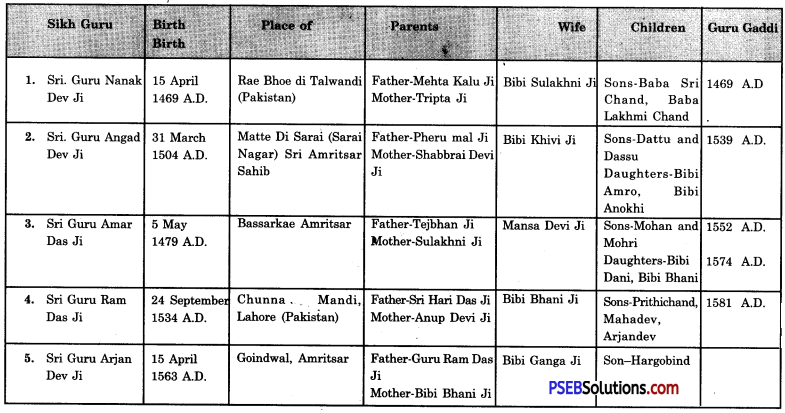Punjab State Board PSEB 9th Class Science Important Questions Chapter 13 Why Do we Fall Ill Important Questions and Answers.
PSEB 9th Class Science Important Questions Chapter 13 Why Do we Fall Ill
Long Answer Type Questions:
Question 1.
Discuss the modes of transmission of diseases.
Answer:
Transmission of Communicable Diseases: Diseases are transmitted from the reservoir of susceptible persons in tire following ways:
1. Direct transmission:
(a) Direct contact between infected and healthy person, e.g. chickenpox, leprosy.
(b) Droplet infection from sneezing, coughing, spitting and talking. e.g. T.B, Whooping cough.
(c) Contact with soil which contains saprophytic disease-causing agents.
(d) Bite of an animal, e.g. Rabies, by bite of rabid dog.
(e) Transplacental transmission (from mother to foetus).
2. Indirect transmission:
1. Air-borne diseases such as common cold, pneumonia and tuberculosis. Such disease causing microbes are spread through the air. This occurs through little droplets thrown out by an infected person who sneezes or coughs. Someone standing closeby can breathe in these droplets, and the microbes get a chance to start a new infection.
2. Water-borne diseases such as cholera, diarrhoea, jaundice. Infectious diseases can be spread through water. This occurs if the stool or other wastes from person suffering from an infectious intestinal disease, gets mixed with the drinking water used by people living nearby. The cholera-causing microbes will enter new hosts through the water they drink and cause disease in them.
3. Sexually-transmitted diseases such as Syphilis and AIDS. Both of these pathogens are transmitted by sexual contact from one partner to the other. Such sexually transmitted
diseases are not spread by casual physical contact. Casual physical contacts include handshakes or hugs or sports as wrestling or by any of the other ways in which we touch each other socially.
4. Spread of disease through vectors. Many animals which live with us may carry diseases. These animals carry the infecting agents from a sick person to another potential host. These animals act as intermediate host and are called vectors. Mosquitoes (Anopheles) are vector of a disease called malaria and dengue fever.

Question 2.
Show the common modes of transmission of diseases.
Answer:
Modes of transmission of diseases
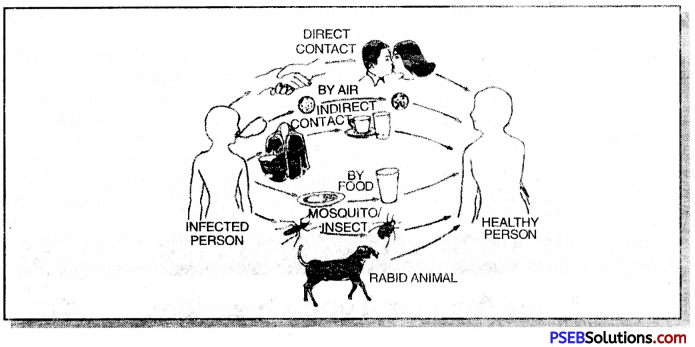
Question 3.
What are general ways of preventing infectious diseases?
Answer:
General ways of preventing infectious diseases:
The general ways of preventing infections mostly relate to preventing exposure. Public hygiene is one basic key to the prevention of infectious diseases.
The following practices are adopted in this method of prevention of diseases:
- For air-borne microbes, we can prevent exposure by providing living conditions that are not overcrowded.
- For water-borne microbes, we can prevent exposure by providing safe drinking water.
- For vector-borne infections, we can provide clean environment. Such a clean environment would not allow mosquito breeding.
Question 4.
Explain acute and chronic diseases.
Answer:
Acute and Chronic diseases: The manifestations of disease will be different depending on a number of factors. One of the most obvious factors that determine how we perceive the disease is its duration. Some diseases last for only very short periods of time, and these are called acute diseases.
The common cold lasts only a few days. Other ailments can last for a long time, even as much as a lifetime and are called chronic diseases. An example is the infection causing elephantiasis, which is very common in some parts of India.

Question 5.
Make a table showing organ specific and tissue-specific manifestation of diseases.
Answer:
Organ-specific and tissue-specific manifestations depend on the target organ which the microbes target after their entry. They are as follows:
| Target organ |
Specific manifestation |
| 1. Lungs |
Cough, breathlessness, chest pain and may be bloody sputum as in TB and lung cancer. |
| 2. Liver |
Inflammation of liver cells leading to jaundice characterized by yellowness of skin and eyes as in
Hepatitis. |
| 3. Intestine |
Inflammation of intestinal mucosa leading to acute diarrhoea and dehydration as in cholera. |
| 4. Nasal chambers |
Inflammation of nasal mucosa leading to sneezing, bronchitis, coughing, fever, etc. as in influenza. |
| 5. Brain |
Headaches, vomiting, fits or unconsciousness. |
Question 6.
Expand AIDS. Explain causes/modes of transmission, effects, incubation period, diagnosis, symptoms and preventive measures of AIDS. What is the significance of 1st December?
Answer:
AIDS (Acquired Immuno-Deficiency Syndrome)
(a) Cause. AIDS is caused by a retro-virus-HIV (Human immuno-deficiency virus).
In India, it was first reported in the prostitutes of Chennai in 1986. It is a pandemic disease.
(b) Epidemiology (Transmission). Human infection occurs through:
- Unprotected sexual intercourse,
- Use of contaminated syringes,
- Blood transfusion,
- Organ transplantation,
- Common razor of the barbers, etc.
Effects: It causes damage, decrease in number of platelets, swollen lymph nodes, ritght sweats, loss of memory, etc. It is a 100% fatal disease.
(c) Incubation period is of about 28 months.
(d) Diagnosis by ELISA test and Western Blot test.
(e) Symptoms: HIV kills the Helper T-lytnphocytes. It is characterized by following symptoms :
- Prolonged fever.
- Swollen lymph nodes.
- Weight loss and loss of appetite.
- Unexplained bleeding.
- Loss of memory and mental ability.
- Patient becomes susceptible to other infectious diseases.
- Night Sweats.
(f) Preventive measures: Involves educating the high risk groups use of disposable syringes; screening tests of blood, organs, semen, etc; monogamous relationship avoiding prostitution, polygamy and heterosexuality, using condoms, avoiding the use of common razor; etc.
(g) Treatment: Drugs like AZT (Azidothymidine), TIAS injection and Protease inhibitors, etc. are known to suppress AIDS virus. Efforts are on for a vaccine against the virus. Ist December is observed as World AIDS Day.

Question 7.
Make a list of common communicable diseases caused by bacteria, viruses, fungi, protozoans and helminthes.
Answer:
Common communicable diseases. The following table shows some important diseases caused by bacteria, fungi and protozoa.
| Name of causative agent |
Diseases |
| 1. Bacteria |
Pneumonia, Tetanus, Tuberculosis, Cholera, Food Poisoning, Sexually transmitted diseases. |
| 2. Viruses |
Chickenpox, poliomyelitis, Influenza, AIDS. |
| 3. Fungi |
Skin diseases, Food poisoning. |
| 4. Protozoans |
Malaria, Kala-Azar, Amoebic dysentery, and African sleeping sickness. |
| 5. Helminthes |
Taeniasis, Cysticercosis, Ascariasis, Elephantiasis. |
Short Answer Type Questions:
Question 1.
Define disease and health?
Answer:
- Disease: It is defined as a condition of the body or a part of it in which functions are disturbed. The word disease means lack of ease and comfort.
- Health: It is a state of complete physical, mental and social well-being. Health is also linked with social environment and cultural background.

Question 2.
What precautions could you take in your school to reduce the incidence of infectious diseases?
Answer:
- Providing safe and clean drinking water.
- Providing clean environment to prevent vector-borne infections.
- Adopting public hygienic measures.
Question 3.
Discuss the principle of prevention of communicable disease.
Answer:
Principles of Prevention: Following three limitations are normally confronted while treating an infectious disease:
- If a person has a disease, his/her body functions are damaged and may never recover completely.
- Treatment will take time, which means that person suffering from a disease is likely to be bedridden for sometime even if given proper treatment.
- The person suffering from an infectious disease can serve as the source from where the infection may spread to other people. It is because of such reasons that prevention of diseases is better than their cure.
Question 4.
Differentiate between infectious and non-infectious diseases.
Answer:
Differences between infectious and non-infectious diseases
| Characters |
Infectious diseases |
Non-infectious diseases |
| 1. Transmission |
Can be transmitted from an infected person to a healthy person. |
Cannot be transmitted from an infected person to a healthy person. |
| 2. Causative agents |
Microorganisms called pathogens. |
Deficiency of nutrient or hormone: or degeneration of tissue or hypersensitivity of body or tumour formation. |
| 3. Nature |
They are brought about by extrinsic factor. |
They are brought about by intrinsic factors. |
| 4. Examples…….. |
Typhoid, Cholera, T.B., AIDS, Malaria etc. |
Diabetes, Kwashiorkor, Marasmus, Goitre, Cancer, Allergy etc. |

Question 5.
What are congenital diseases? Name the three types. Give examples.
Answer:
Congenital diseases: These are inborn diseases present since birth caused by gene or chromosomal mutation.
Types of congenital diseases:
- Diseases caused by gene mutation, e.g. Haemophilia, colorblindness, alcaptonuria and sickle cell anaemia.
- Diseases caused by chromosomal mutation, e.g. Down’s syndrome, Klinefelter’s syndrome, Turner’s syndrome.
- Diseases caused by environmental factors such as radiations or pollutants. They are non-inheritable,
Question 6.
List various modes of direct transmission of diseases, giving one example of each type.
Answer:
- By direct contact with an infected person e.g. Leprosy, chickenpox etc.
- By droplet infection e.g. Diphtheria, tuberculosis, etc.
- By contact with soil e.g. bacterial cysts of tetanus.
- By animal bite e.g. rabies viruse.
- Transplacental transmission e.g. viruses of German measles and AIDS.
Question 7.
What are sources of diseases? Name various sources of diseases, giving one example of each.
Answer:
1. Sources of diseases are those sites which are occupied by the pathogens before entering inside the human body. These are also called reservoirs of infection.
2. Types of sources of diseases:
(a) Carriers or vectors e.g. Plasmodium (female Anopheles).
(b) Soil e.g. bacterial cysts of Clostridium tetani.
(c) Air e.g. bacterial cysts of TB.
(d) Food and water e.g. bacterial cysts of Cholera.
Question 8.
Differentiate symptoms and signs.
Answer:
Differences between symptoms and signs:
| Symptoms |
Signs |
| 1. They indicate presence of disease.
2. They are collective manifestations of a number of diseases of a particular part or organ. |
1. They provide information about the presence of particular diseases.
2. They are distinct for different diseases. |

Question 9.
Differentiate acute diseases and chronic diseases.
Answer:
Differences between acute diseases and chronic diseases:
| Acute diseases |
Chronic diseases |
| 1. They occur very rapidly but for only short period.
2. Do not cause major effects on general health.
3. Examples: Common cold. Cough. |
1. These diseases last for a long time and could be dangerous.
2. They have prolonged and major effects on general health.
3. Examples: T.B., Cancer, Diabetes, Arthritis. |
Question 10.
How do antibiotics function?
Answer:
Action of antibiotics: Antibiotics commonly block biochemical pathways important for bacteria. Many bacteria, for example, make a cell-wall to protect themselves. The best illustration is action of penicillin, ft blocks the bacterial processes that build the cell-wall. As a result, the growing bacteria become unable to make cell-walls, and die easily.
Human cells don’t make a cell-wall anyway, so penicillin cannot have such an effect on us. Penicillin will have this effect on any bacteria that use such processes for making cell-walls. Similarly, many antibiotics work against many species of bacteria rather than simply working against one.
Question 11.
Why do antibiotics not work against viral infection?
Answer:
Viruses do not have their own metabolic pathways at all, and that is the reason why antibiotics do not work against viral infections. In case of common cold, taking antibiotics does not reduce the severity or the duration of the disease.
Question 12.
What is hydrophobia? How does it occur in man? Why is it called a neurotrophic disease?
Answer:
- Hydrophobia is another name of a viral disease called Rabies.
- It is caused by a RNA-virus, Rabies vires, which is injected in the human being along with saliva of rabid animals like dogs, cats, monkeys etc.
- Because the virus damages the motor neurons of brain and spinal cord, therefore causes paralysis and death.

Question 13.
What are vaccines?
Answer:
Vaccines are produced by deliberate infection of animals, recombinant DNA techniques coupled with hybridomas have opened up the way for custom-made monoclonal antibodies for preventive and therapeutic use. The vaccination prepares the body to fight against the attack.
Question 14.
Give a few examples of vector-borne diseases.
Answer:
Vector-borne diseases:
| Vector |
Disease |
| Tse Tse fly (Glossina)
Sandfly (Phlebotomus)
Female mosquito (Anopheles)
Rat flea (Xenopsilla)
Aedes mosquito |
African sleeping sickness
Kala-azar and Oriental sore
Malaria
Bubonic plague
Yellow fever, Dengue. |
Question 15.
Write the name of causal organism of the following diseases:
- Malaria
- Rabies
- Influenza
- Tuberculosis
- Typhoid
Answer:
| Disease |
Casual Organism |
| 1. Malaria
2. Rabies
3. Influenza
4. Tuberculosis
5. Typhoid |
Plasmodium vivax
Rabies-virus
Myxovirus influenzae
Mycobacterium tuberculosis
Salmonella typhosa |
Question 16.
Draw simple diagrams to show the structure of Staphylococcus, Heliobacter, SARS, Leishmania and Trypanosoma.
Answer:
Structure of disease-causing agents

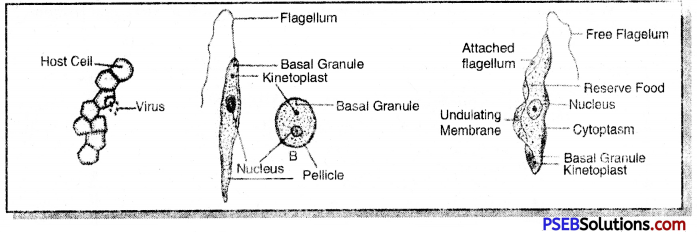
Question 17.
Name the infectious disease that leads to immunodeficiency and wasting of body parts. Give the scientific name of the pathogen causing the disease and mention the body organs it primarily affects.
Answer:
- AIDS is characterized by immunodeficiency and wasting of body parts.
- It is caused by Human Immunodeficiency Virus (HIV).
- HIV attacks helper T-lymphocytes, so causing cell-mediated immunodeficiency, so making the body more prone to various infections.

Question 18.
Which disease is called epidemic jaundice? List its main symptoms? How can it be prevented?
Answer:
- Epidemic jaundice is commonly called Hepatitis-A.
- It is characterized by yellowing of skin, urine and stool due to damage of liver cells and overproduction of bilirubin.
- It can be prevented by proper sanitation, use of boiled or ozonised water and intramuscular injection of human immunoglobulins.
Question 19.
Explain the differences between active and passive immunization.
Answer:
Differences between active immunization and passive immunization:
| Active Immunization |
Passive Immunization |
| 1. Antigens are introduced from outside which trigger off the formation of antibodies in the body. |
1. Ready-made antibodies are introduced into the body. |
| 2. It does not provide immediate relief. |
2. It provides immediate relief. |
| 3. Immunity thus achieved is long-lasting. |
3. It is not long-lasting. |
Question 20.
How is health at risk in a cyclone?
Answer:
Health is at risk in case of cyclone because:
- Social environment is disturbed as it is an important factor in case of individual health.
- Garbage collected in places is source of multiplication of microbes and breeding place for various vectors.
- Stagnant water will provide breeding surface for mosquitoes and other such disease spreading agents.
Question 21.
Show by simple diagram how airborne diseases are easier to catch the person who is near the infected person.
Answer:
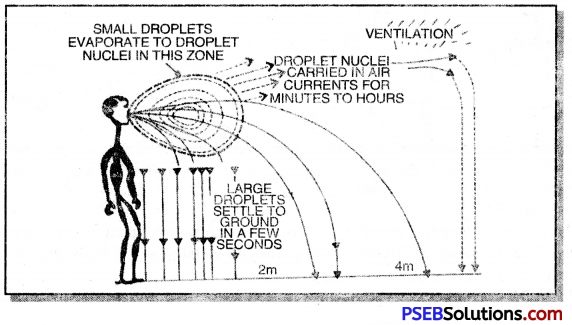
Fig. Air-transmitted diseases are easier to catch the closer we are to the infected person. However, in closed areas, the droplet nuclei recirculate and pose a risk to everybody. Overcrowded and poorly ventilated housing is therefore a major factor in the spread of airborne diseases.

Question 22.
Draw a diagram showing structure of HIV Virus.
Answer:
Structure of HIV Virus
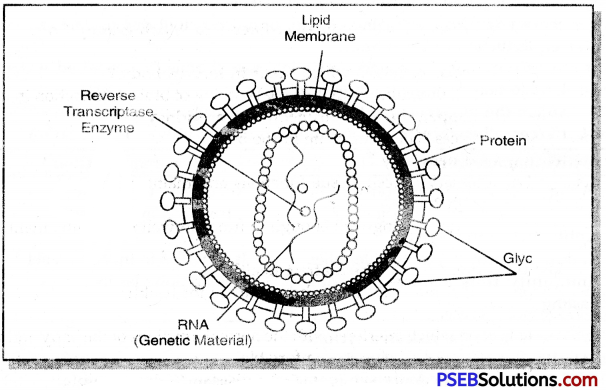
Question 23.
What is meant by hydrophobia (rabies)? Write its four symptoms. Suggest four preventive measures to check this disease.
Answer:
Rabies: It is caused by bite of rabid or mad dog and other rabid animals.
Causative agent: Rabies virus present in saliva of dog.
Symptoms:
- High fever.
- Severe headache.
- Painful contraction of muscles of throat and chest.
- Fear of water.
Preventive measures:
- Wound should be cleaned.
- Immunise dogs and cats.
- Kill highly rabid dogs.

Question 24.
A person is suffering from chest pain, breathlessness, loss of body weight, persistent cough and produces blood stained sputum.
- Name the disease and its causative agent.
- Mention two means of its transmission.
- Name the vaccine used to prevent this disease.
- Who discovered this disease?
Answer:
- Person is suffering from pulmonary tuberculosis: Causative agent Bacterium namely Mycobacterium tuberculosis.
- Modes of transmission: It is a communicable disease. Droplet infection during sneezing or otherwise.
- BCG vaccine can prevent TB.
- Robert Koch (1882).
Very Short Answer Type Questions:
Question 1.
Health and diseases are complex problems in which group of organisms?
Answer:
Human.
Question 2.
List four special activities which occur in human body?
Answer:
- Heartbeat
- Breathing with lungs
- Working of brain
- Excretion in kidneys.
Question 3.
What will happen due to malfunctioning of kidney?
Answer:
Toxic substances will accumulate in the body.
Question 4.
Why is food necessary?
Answer:
Food is necessary for cell, tissue functions and maintenance.

Question 5.
What is health?
Answer:
Health is a state of being well enough to function well physically, mentally and socially.
Question 6.
List two other factors which affect health.
Answer:
Personal and community issues both matters for health.
Question 7.
Define disease.
Answer:
Any condition which interferes with the normal functions of the body and impairs the health. It literally means being uncomfortable.
Question 8.
What do you mean by symptoms of a disease? Give example.
Answer:
Symptoms of a disease are things we feel as being wrong, e.g. headache, cough, loose motions etc.
Question 9.
What are the signs of disease?
Answer:
Signs indicate a little more definite indications of presence of disease.
Question 10.
What are two types of diseases on the basis of duration?
Answer:
- Acute diseases
- Chronic diseases

Question 11.
What do you understand by acute diseases?
Answer:
The diseases which last only for a short period of time.
Question 12.
Define chronic diseases.
Answer:
Diseases which last for long time, even life time are called chronic diseases.
Question 13.
Give two examples of acute diseases.
Answer:
1. Cough and cold
2. Flu
Question 14.
Write example of chronic disease.
Answer:
Elephantiasis.
Question 15.
Which kind of diseases are more harmful to the body?
Answer:
Chronic diseases.

Question 16.
What is the cause of dysentary?
Answer:
Contaminated food and water.
Question 17.
Name two types of diseases on the basis of their occurrence.
Answer:
- Congenital diseases
- Acquired diseases
Question 18.
Why are communicable diseases called infectious diseases?
Answer:
Because these are caused by the infection and multiplication of some kind of micro-organisms like bacteria, viruses etc.
Question 19.
What are congenital diseases?
Answer:
Diseases present in the body from the birth. They are mostly hereditary disorders.
Question 20.
Name a disease which is no longer chronic disease.
Answer:
Peptic ulcer.
Question 21.
Name the bacterium responsible for peptic ulcer.
Answer:
Helicobacter pylori.

Question 22.
Who discovered that Helicobacter pylori causes peptic ulcer and were awarded Nobel prize?
Answer:
Robin Warren and Barry Marshall.
Question 23.
Name a few disease-causing microbes.
Answer:
Viruses, Bacteria, Fungi and some Protozoans.
Question 24.
Name any four diseases caused by bacteria.
Answer:
Typhoid, Cholera, Tuberculosis (TB), Anthrax.
Question 25.
List a few common diseases caused by viruses.
Answer:
Common cold, Influenza, Dengue fever and AIDS.
Question 26.
Write examples of protozoanal diseases.
Answer:
Malaria, Kala-azar, Amoebic dysentary.
Question 27.
Name a cutaneous disease caused by fungi.
Answer:
Ringworm.
Question 28.
Name two 100% fatal diseases.
Answer:
Rabies and AIDS.

Question 29.
What is the common name of influenza? Give its causative agent.
Answer:
Influenza is commonly called flu. It is caused by Myxovirus influenza virus.
Question 30.
How does Penicillin acts as a useful antibiotic?
Answer:
Penicillin blocks the pathway that build the cell wall as a result growing bacteria are unable to form a cell wall.
Question 31.
Why antibiotic do not affect cough and cold?
Answer:
Cough and cold are mostly caused by viruses and antibiotics fail to act on viruses.
Question 32.
Name three sexually transmitted diseases.
Answer:
AIDS, Syphilis, Gonorrhea.
Question 33.
Sexually transmitted diseases are not spread by which factors?
Answer:
Handshake, embracing, wrestling.
Question 34.
How do bacteria causing T.B. reach lungs?
Answer:
Through nose during breathing.

Question 35.
How do bacteria causing typhoid enter body.
Answer:
During intake of contaminated food and water.
Question 36.
What is the cause of jaundice?
Answer:
Hepatitis virus.
Question 37.
Who proposed the name malaria from bad air?
Answer:
Macculoch (1827).
Question 38.
Why is rabies called a neurotrophic disease?
Answer:
Because the toxins of Rabies-virus damage the motor neurons of the brain.
Question 39.
Expand the term AIDS.
Answer:
Acquired Immuno Deficiency Syndrome.
Question 40.
Give the full form of HIV.
Answer:
Human-Immuno Deficiency Virus.

Question 41.
What is the significance of December 1?
Answer:
World AIDS Day falls on December 1.
Question 42.
Which disease is characterized by yellowing of skin?
Answer:
Hepatitis (epidemic jaundice).
Question 43.
Name three modes of transmission of AIDS.
Answer:
- Sexual intercourse with infected partner
- Use of contaminated syringes and
- Contaminated blood transfusion.
Question 44.
Who prepared the first vaccine?
Answer:
Edward Jenner.
Question 45.
Why is it difficult to make antiviral substances?
Answer:
Viruses do not have their own biochemical pathways, instead they utilize the machinery of cells they attack, therefore, it is difficult to make antiviral substances.
Question 46.
Define vectors.
Answer:
Vectors: They are organisms which spread the disease-causing agents from infected person to a healthy person.
Question 47.
Encephalitis attack which organ of body?
Answer:
Brain.

Question 48.
List a few symptoms of encephalitis.
Answer:
Headache, Vomitting, Unconsciousness.
Question 49.
Name a disease which does not occur after one attack?
Answer:
Small-pox.
Question 50.
Which disese have been eliminated from the world.
Answer:
Small pox.
Question 51.
List some common modes of spread of disease.
Answer:
- Direct contact
- Air
- Indirect contact
- Insect bites
- Contaminated food and water
- Rabid animal.

Question 52.
Name the two ways of preventing diseases.
Answer:
- General way is preventing exposure.
- Strong immune system.
Question 53.
Name a few diseases for which vaccines are available.
Answer:
Whooping cough, Diphtheria, Measeles, Polio and Tuberculosis.
Question 54.
What is immune system?
Answer:
The system of animal body, which protects it from various infectious agents and cancer is termed immune system.
Question 55.
List two features for individual health.
Answer:
Good economic conditions of jobs and stress-free life are needed for individual health.
![]()
![]()
![]()
![]()
![]()
![]()
![]()






